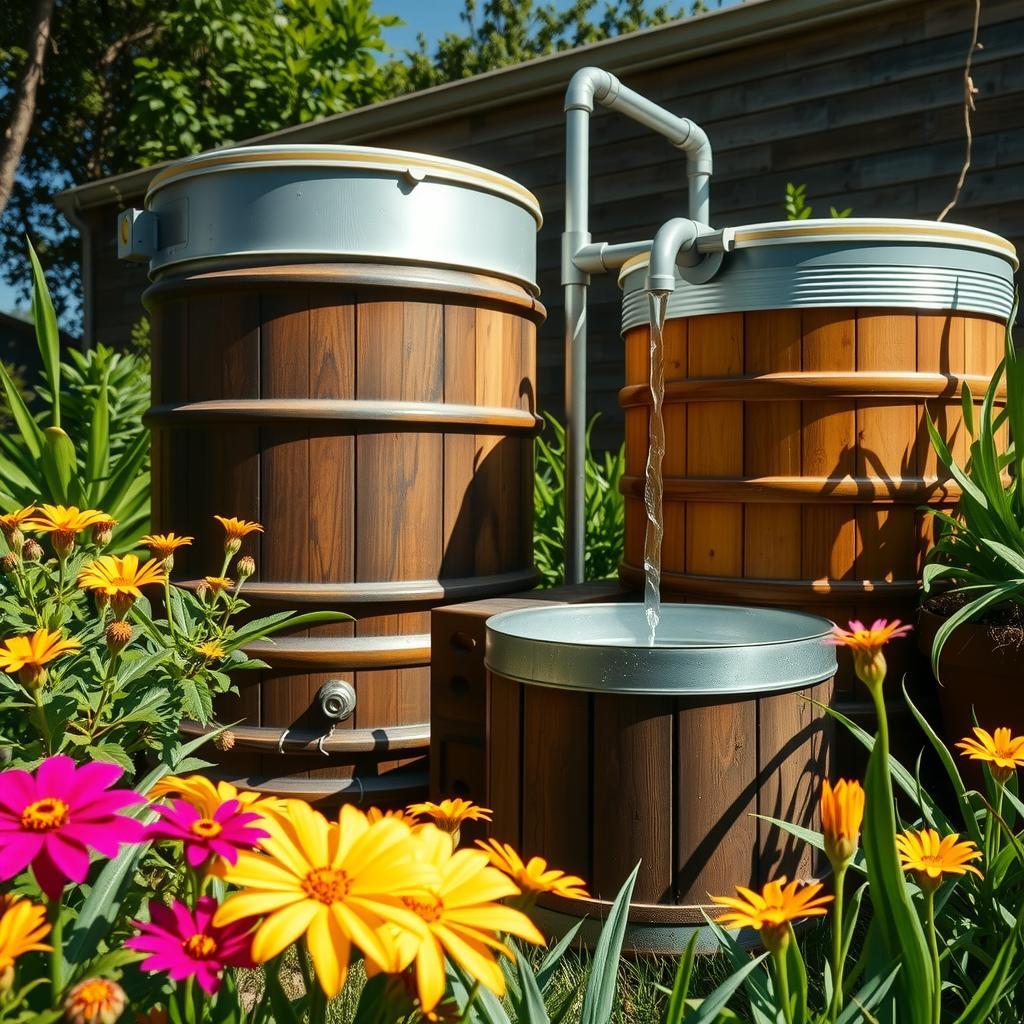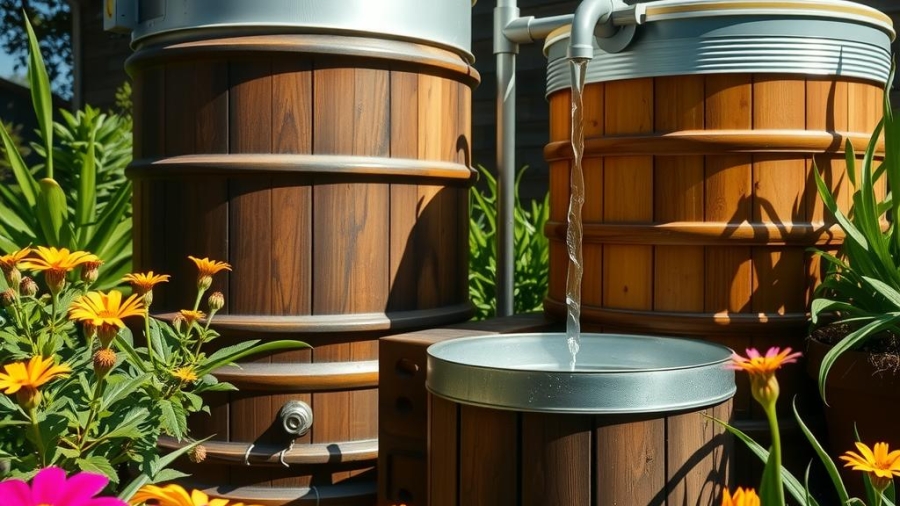As water scarcity becomes an increasingly pressing issue, many homeowners are searching for effective ways to reduce their reliance on municipal supplies while also cutting down on costs. This growing concern has led to a surge in interest surrounding rainwater harvesting, a practice that not only promotes water conservation but also encourages sustainable living practices. However, the idea of installing a rainwater collection system often seems daunting and expensive, leading many individuals to shy away from this eco-friendly solution. What if it were possible to create your very own DIY system without breaking the bank?
This blog post dives into the fascinating world of budget-friendly solutions for rainwater harvesting, demonstrating how anyone can implement an efficient and cost-effective setup for under $500. By harnessing natural precipitation through simple home improvement techniques, homeowners can significantly reduce their water bills while contributing positively to the environment. The core value lies in empowering readers with practical knowledge about how they can easily construct their own system—eliminating barriers associated with high initial investments or complex installations.
Imagine transforming runoff from your roof into a valuable resource that nourishes your garden or replenishes household needs! With just a few essential materials and some basic tools, creating an efficient rainwater collection setup is more achievable than ever before. As we explore step-by-step instructions and essential components needed for this project, readers will find themselves equipped with everything necessary to embark on this journey toward sustainability.
So whether one is looking to cultivate self-sufficiency or simply make smarter choices regarding water usage at home, this guide serves as both inspiration and instruction. Join us as we unravel the exciting possibilities of building a DIY rainwater harvesting system that aligns perfectly with eco-conscious living—all within budget constraints!

Key Points:
-
Understanding Rainwater Harvesting: This section introduces the concept of rainwater harvesting, highlighting its significance in addressing water scarcity and promoting water conservation. Homeowners are encouraged to consider this eco-friendly practice as not just a necessity, but an opportunity for innovative home improvement.
-
Building Your Own DIY System: Here, readers will learn about the various components required to create their very own DIY system. The guide emphasizes sourcing materials from local hardware stores or online retailers, ensuring that crafting an effective rainwater collection setup remains accessible and budget-friendly. It empowers individuals by showcasing how simple adjustments can lead to significant savings.
-
Maximizing Efficiency and Maintenance: This part focuses on tips for maintaining the rainwater harvesting system once established. By understanding optimal collection techniques and regular upkeep, homeowners can enhance efficiency over time. This ensures that they reap long-term benefits from their investment while contributing positively towards sustainable living practices.
Understanding Water Scarcity
A Global Challenge
Water scarcity has become a pressing issue worldwide, affecting millions of people and ecosystems. As populations grow and climate change exacerbates weather patterns, the demand for fresh water is rapidly outstripping supply. Urbanization and industrial activities further strain existing water resources, leading to an urgent need for innovative solutions to ensure access to clean water. Rainwater harvesting emerges as a viable strategy that not only alleviates pressure on traditional sources but also promotes sustainable living practices. By collecting rainwater from roofs and other surfaces, communities can reduce dependency on municipal systems while enhancing their resilience against drought conditions.
Benefits of Rainwater Harvesting
Sustainable Resource Utilization
Utilizing harvested rainwater offers numerous benefits that extend beyond mere conservation efforts. It serves as a reliable source of irrigation for gardens or landscaping, contributing to improved home aesthetics while reducing reliance on treated municipal water supplies. Moreover, implementing a DIY system for rainwater collection empowers homeowners with budget-friendly solutions tailored to their specific needs. This practice encourages participation in eco-friendly initiatives that align with broader goals of environmental stewardship and resource management. Consequently, as individuals invest in such sustainable practices at home, they foster community awareness regarding the importance of protecting our limited freshwater resources.
Enhancing Home Improvement Projects
Integrating Eco-Friendly Practices
Incorporating rainwater harvesting into home improvement projects elevates both functionality and sustainability within residential spaces. By adding simple yet effective collection systems like barrels or tanks connected to gutters, homeowners can significantly enhance their ability to manage stormwater runoff—ultimately benefiting local waterways by reducing pollution levels during heavy rains. Such enhancements not only contribute positively towards personal property value but also reflect an increasing societal trend toward responsible consumption habits through effective water conservation strategies.
Economic Advantages of Rain Collection
Cost-Effective Solutions
Adopting rainwater collection methods presents substantial economic advantages alongside environmental benefits. The initial investment in setting up a basic system often leads to significant savings over time due to decreased water bills; this makes it an attractive option for those seeking cost-effective ways to manage household expenses sustainably. Additionally, various government incentives may be available specifically designed for promoting eco-friendly installations like these systems—which further drives interest in adopting such budget-friendly solutions among homeowners looking towards greener alternatives without sacrificing quality or practicality.
Fostering Community Awareness
Promoting Collective Action
Ultimately, embracing the concept of rainwater harvesting fosters greater community awareness about the critical importance of responsible resource management practices amidst ongoing global challenges related to freshwater availability—the more individuals engage actively with this approach collectively enhances overall resilience against future crises stemming from insufficient drinking supplies or agricultural viability issues triggered by climate impacts globally facing today’s world population pressures today! Encouraging neighborhoods through workshops demonstrating how easy implementing such positive changes can bring together diverse groups under common objectives will empower citizens while cultivating long-lasting partnerships aimed at preserving essential natural resources vital not just locally but universally across generations ahead too!
Choosing the Right Materials for Your Rainwater Collection System
A Foundation for Effective Water Harvesting
When embarking on a DIY system for rainwater collection, selecting appropriate materials is paramount. Homeowners should consider durable and non-toxic options that promote sustainable living while ensuring efficiency. For instance, using high-quality gutters made from aluminum or PVC can effectively channel rainfall into storage tanks without corroding over time. Moreover, opting for food-grade barrels or cisterns will guarantee that the collected water remains clean and safe for irrigation purposes. When assembling these elements, it’s essential to ensure proper sealing and installation to minimize leaks and maximize collection capacity during rainfall events. By prioritizing eco-friendly practices in material selection, individuals not only contribute to water conservation but also enhance their home improvement efforts with an environmentally responsible touch.
Setting Up Efficient Collection Techniques
Transforming Rainfall Into Resourceful Water Solutions
Establishing effective collection techniques is crucial in maximizing the benefits of a rainwater harvesting system. One widely adopted method involves installing downspouts connected directly to storage containers positioned strategically around the property. This setup allows homeowners to capture runoff efficiently as soon as it leaves rooftops, significantly increasing overall yield during rainy periods. Additionally, incorporating filtration systems at entry points can prevent debris from contaminating stored water while maintaining its quality for later use in gardens or landscape irrigation systems. Tailoring these techniques according to individual household needs ensures flexibility; families may choose larger tanks if they have expansive garden areas requiring consistent watering or smaller units if aiming primarily at reducing municipal water usage during dry spells. Such adaptability aligns seamlessly with budget-friendly solutions aimed at enhancing ecological responsibility without sacrificing convenience.
Regular Inspections
The Importance of Routine Checks for Rainwater Harvesting Systems
Regular inspections are crucial in ensuring the longevity and efficiency of a rainwater harvesting system. Homeowners should routinely check all components, including gutters, downspouts, and storage tanks, to ensure they are free from debris and blockages. A clean system not only maximizes water flow but also prevents potential contaminants from entering the collected water supply. Additionally, inspecting seals and joints can help identify leaks early on, reducing water waste and maintenance costs over time. By taking a proactive approach with frequent assessments, homeowners can maintain their DIY rainwater collection systems, enhancing both functionality and durability while supporting broader goals of sustainable living.
Effective Filtration Techniques
Maximizing Water Quality Through Filtration
Implementing effective filtration techniques is essential for maintaining the quality of harvested rainwater in any home improvement project involving a rainwater collection system. Utilizing mesh filters at entry points helps prevent larger debris such as leaves or twigs from contaminating stored water. Furthermore, installing sedimentation tanks allows finer particles to settle before reaching storage containers—ensuring cleaner water for various uses around the home. Incorporating advanced filtration methods such as UV treatment or activated carbon filters can significantly enhance safety by eliminating pathogens or unpleasant odors commonly associated with stagnant water sources. Investing in these eco-friendly practices contributes not only to better health outcomes but also supports overall efforts toward efficient water conservation.
Seasonal Maintenance Practices
Preparing Your System for Changing Weather Conditions
Seasonal maintenance is vital to adapt your rainwater harvesting system against varying weather conditions throughout the year. As seasons change, it’s important to clear out gutters regularly; this ensures that heavy rains do not lead to overflow issues during peak rainfall periods—maximizing capture efficiency when it’s most needed. In colder climates, special attention must be given prior to winter months by insulating pipes and drains against freezing temperatures that could cause damage or blockage during thaw cycles. This level of preparedness offers budget-friendly solutions while safeguarding investments made into sustainable systems designed for long-term usage within an eco-conscious lifestyle framework.
Frequently Asked Questions:
Q: What materials do I need to create a DIY rainwater harvesting system?
A: To build an effective DIY system, homeowners will typically require a few essential components such as gutters, downspouts, storage containers like barrels or tanks, and filtration systems. These materials can be easily sourced from local hardware stores at budget-friendly prices.
Q: How can I ensure my rainwater collection is safe for use in my garden?
A: It’s important to utilize appropriate filtration methods when collecting rainwater to ensure it remains clean and safe for gardening purposes. Incorporating screens or first-flush diverters into the rainwater harvesting setup can help eliminate debris and contaminants, promoting effective water conservation practices while protecting your plants.
Q: Can I install a rainwater harvesting system on different types of properties?
A: Yes! One of the advantages of creating a sustainable living solution like this is its versatility. Homeowners with various property types—whether urban rooftops or rural homes—can customize their rainwater collection systems according to their specific needs and available space, making it an ideal option for anyone looking to enhance home improvement efforts sustainably.
